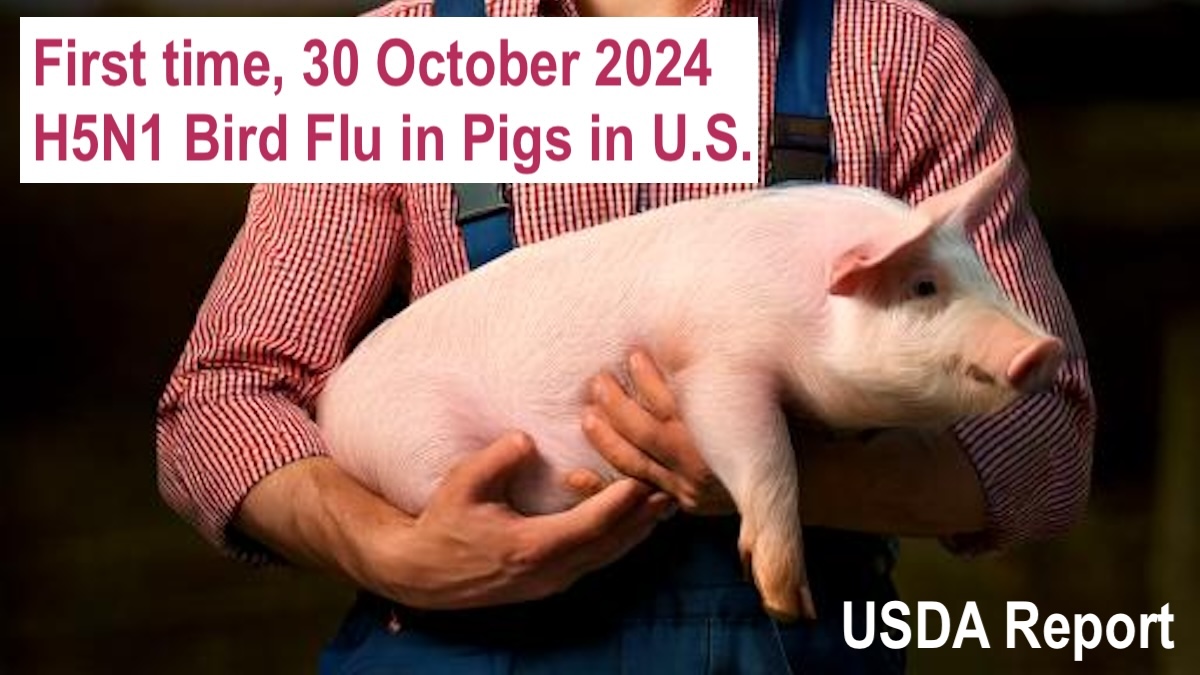WARNING. Average H5N1 Case Fatality Rate (CFR) in humans is 25-50%
USDA. Federal and State Veterinary Agencies Share Update on HPAI Detections in Oregon Backyard Farm, Including First H5N1 Detections in Swine.
30 October 2024
There is no concern about the safety of the nation’s pork supply as a result of this finding.
Press Release
Contact: aphispress@usda.gov
WASHINGTON, Oct. 30, 2024 – The U.S. Department of Agriculture (USDA) and Oregon state veterinary officials are investigating positive cases of H5N1 in a backyard farming operation in Oregon that has a mix of poultry and livestock, including swine. The Oregon Department of Agriculture announced on Friday, Oct. 25, that poultry on this farm represented the first H5N1 detection in Crook County, Oregon. On Tuesday, Oct. 29, the USDA National Veterinary Services Laboratories also confirmed one of the farm’s five pigs to be infected with H5N1, marking the first detection of H5N1 in swine in the United States.
The livestock and poultry on this farm shared water sources, housing, and equipment; in other states, this combination has enabled transmission between species. Although the swine did not display signs of illness, the Oregon Department of Health and USDA tested the five swine for H5N1 out of an abundance of caution and because of the presence of H5N1 in other animals on the premises. The swine were euthanized to facilitate additional diagnostic analysis. Test results were negative for two of the pigs, and test results are still pending for two others.
This farm is a non-commercial operation, and the animals were not intended for the commercial food supply. There is no concern about the safety of the nation’s pork supply as a result of this finding.
In addition, the farm has been quarantined to prevent further spread of the virus. Other animals, including sheep and goats on the farm, remain under surveillance.
USDA’s National Veterinary Services Laboratories (NVSL) has conducted genomic sequencing of virus from the poultry infected on this farm, and that sequencing has not identified any changes to the H5N1 virus that would suggest to USDA and CDC that it is more transmissible to humans, indicating that the current risk to the public remains low.
Local public health officials, Oregon Health Authority, Oregon State Veterinarian, Oregon Department of Agriculture, as well as the U.S. Department of Agriculture and U.S. Department of Health and Human Services are coordinating on this investigation and will provide additional updates as they become available.
All detections of H5N1 include viral genome sequencing to provide additional information of interest to medical professionals and the research community to improve our understanding of the virus. Genetic sequencing for these samples is underway, though sequencing results may be inconclusive due to low viral levels in the samples.
USDA reminds all farmers that strong biosecurity is critical to eradicating this virus and to protecting the health of farmworkers, farmers and their families, livestock and businesses. More information about biosecurity, specifically regarding best practices for farms with multiple species, as well as how to access financial assistance to offset the cost of biosecurity and PPE for farmworkers is available here. Enrollment in these programs can be started with your local Area Veterinarian in Charge (AVIC) or State Animal Health Official. Your nearest USDA Farm Service Agency county office has more information and can also help you enroll.
USDA continues to invest heavily in vaccine research and development as a tool to help stem and potentially stop the spread of this virus among animals. USDA has approved two vaccine field safety trials for vaccine candidates designed to protect dairy cows from H5N1, and continues to explore vaccine options for other species.
As USDA takes additional steps to protect the health of livestock, the Department will continue to work closely with its federal partners at CDC to protect the health of people and FDA to protect the safety of the food supply. These collective, collaborative efforts have helped protect farmworkers and farmers, the health and welfare of livestock animals, and reaffirmed the safety of the nation’s food supply. The U.S. government remains committed to addressing this situation with urgency.
To learn more about USDA’s response to HPAI in dairy cattle, visit www.aphis.usda.gov/livestock-poultry-disease/avian/avian-influenza/hpai-detections/livestock.
APHIS protects the health of U.S. agriculture and natural resources against invasive pests and diseases, regulates genetically engineered crops, administers the Animal Welfare Act, and helps people and wildlife coexist. We also certify the health of U.S. agricultural exports and resolve phytosanitary and sanitary issues to open, expand, and maintain markets for U.S plant and animal products.
USDA touches the lives of all Americans each day in so many positive ways. In the Biden-Harris Administration, USDA is transforming America’s food system with a greater focus on more resilient local and regional food production, fairer markets for all producers, ensuring access to safe, healthy and nutritious food in all communities, building new markets and streams of income for farmers and producers using climate smart food and forestry practices, making historic investments in infrastructure and clean energy capabilities in rural America, and committing to equity across the Department by removing systemic barriers and building a workforce more representative of America. To learn more, visit www.usda.gov.


